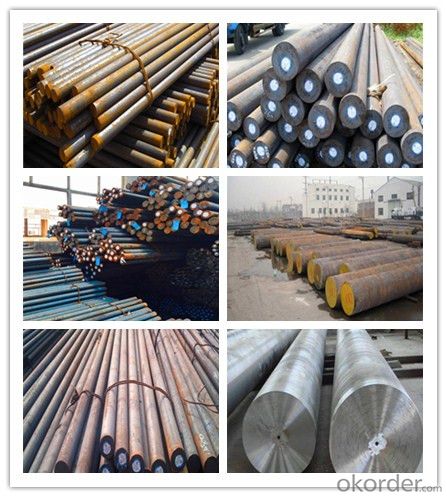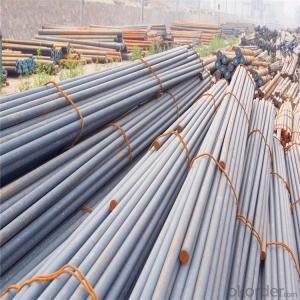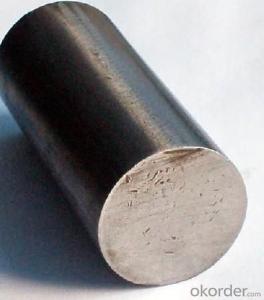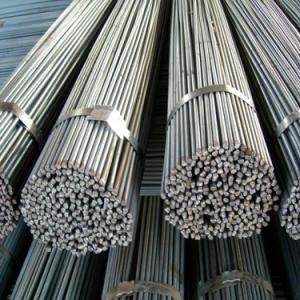Structural Steel Bar EN10025(93) S355J2G3
- Loading Port:
- Tianjin
- Payment Terms:
- TT OR LC
- Min Order Qty:
- 100 m.t.
- Supply Capability:
- 500000 m.t./month
OKorder Service Pledge
OKorder Financial Service
You Might Also Like
Item specifice
Structural Steel Bar EN10025(93) S355J2G3
Product Description of Structural Steel Bar EN10025(93) S355J2G3
1. Steel grade: ASTM4140, SCM440, 42CrMo, DIN1.7225
2. Length: 6M-12M
3. Diameter: 16mm-300mm
4. Product range: round bar, flat bar, square bar
5. Technique: Hot rolled, forged, cold drawn
Specification of Structural Steel Bar EN10025(93) S355J2G3
Material | SCM4140 | Round bar | Dia(mm) | 16-300mm |
Process | EAF + LF + VD + Forged + Heat Treatment (optional) | Length (mm) | Max 12m | |
Heat treatment | Normalized / Annealed / Quenched / tempered | Flat bar | Thickness(mm) | 8-500mm |
Delivery condition | Hot forged +Rough machined (black surface after Q/T)+ Turned (optional) | Width(mm) | 70-200mm | |
Test | Ultrasonic test according to SEP 1921-84 D/d | Length (mm) | Max 12m |
Chemical Composition of Structural Steel Bar EN10025(93) S355J2G3
C | Si | Mn | Cr | Mo | P | S |
0.38~0.43 | 0.15~0.35 | 0.75~1.00 | 0.8~1.1 | 0.15~0.25 | ≤0.035 | <0.04< td=""> |
Photo Show of Structural Steel Bar EN10025(93) S355J2G3

Packing and Delivery:
Packing in bundle package, or as customer's requirements.
Delivery Detail: 45 days after receiving the deposit.
Usage and Applications of Structural Steel Bar EN10025(93) S355J2G3
1. Steel round bar is used in a large number of architectural and engineering structures. Or it can be used in construction of plants for the production of steel house frames, high-voltage transmission towers, bridges, vehicles, boilers, containers, ships, etc.
2. And we can use this kind of product on the performance of the mechanical parts if the demand is not very high.
3. Some special material steel round bar can be used for main shaft of steamer, hummer shank, with big section and supper force.
Company Information
CNBM International Corporation is the most important trading platform of CNBM group.
Whith its advantages, CNBM International are mainly concentrate on Cement, Glass, Iron and Steel, Ceramics industries and devotes herself for supplying high qulity series of refractories as well as technical consultancies and logistics solutions.


F A Q
1, Your advantages?
professional products inquiry, products knowledge train (for agents), smooth goods delivery, excellent customer solution proposale
2, Test & Certificate?
SGS test is available, customer inspection before shipping is welcome, third party inspection is no problem
3, Factory or Trading Company?
CNBM is a trading company but we have so many protocol factories and CNBM works as a trading department of these factories. Also CNBM is the holding company of many factories.
4, Payment Terms?
30% TT as deposit and 70% before delivery.
Irrevocable L/C at sight.
5, Trading Terms?
EXW, FOB, CIF, FFR, CNF
6, After-sale Service?
CNBM provides the services and support you need for every step of our cooperation. We're the business partner you can trust.
For any problem, please kindly contact us at any your convenient time.
We'll reply you in our first priority within 24 hours.
- Q:Can steel round bars be used in the aerospace manufacturing industry?
- Yes, steel round bars can be used in the aerospace manufacturing industry. Steel round bars are commonly used in various aerospace applications such as structural components, landing gear, engine components, and fasteners. The high strength and durability of steel make it suitable for these critical aerospace applications. Additionally, steel round bars can be easily machined and formed into complex shapes, allowing for customization and precise engineering requirements in the aerospace industry. Furthermore, steel's resistance to corrosion and its ability to withstand extreme temperatures make it a reliable choice for aerospace manufacturing. Overall, steel round bars are a versatile and widely used material in the aerospace industry due to their strength, durability, machinability, and resistance to corrosion.
- Q:What are the advantages of using nickel-chromium-titanium alloy steel round bars?
- There are several advantages of using nickel-chromium-titanium alloy steel round bars: 1. High Strength: Nickel-chromium-titanium alloy steel round bars are known for their exceptional strength and durability. They have a high tensile strength, making them suitable for applications requiring heavy-duty materials. 2. Corrosion Resistance: These alloy steel round bars have excellent corrosion resistance properties due to the presence of nickel and chromium. This makes them ideal for use in environments where exposure to moisture, chemicals, or harsh conditions is common. 3. Heat Resistance: Nickel-chromium-titanium alloy steel round bars can withstand high temperatures without losing their mechanical properties. They exhibit good heat resistance, making them suitable for applications in industries such as aerospace, power generation, and automotive. 4. Fatigue Resistance: The unique composition of nickel-chromium-titanium alloy steel round bars provides excellent fatigue resistance, allowing them to withstand repeated stress and load cycles without deformation or failure. This makes them suitable for applications in high-stress environments. 5. Machinability: Despite their high strength and toughness, nickel-chromium-titanium alloy steel round bars are relatively easy to machine. They can be easily cut, drilled, or shaped, allowing for efficient and precise manufacturing processes. 6. Versatility: These alloy steel round bars have a wide range of applications due to their versatile properties. They can be used in industries such as construction, automotive, aerospace, marine, and many more. Their high strength and corrosion resistance make them suitable for various structural and load-bearing applications. Overall, nickel-chromium-titanium alloy steel round bars offer a combination of high strength, corrosion resistance, heat resistance, fatigue resistance, machinability, and versatility, making them a preferred choice for many industrial applications.
- Q:How are steel round bars used in the manufacturing of fasteners and bolts?
- Steel round bars are used in the manufacturing of fasteners and bolts as they provide the necessary strength and durability required for these components. The bars are typically cut and shaped into the desired length and shape, and then undergo various processes such as threading or heat treatment to enhance their performance. The resulting steel rods are used as the main body of fasteners and bolts, providing the necessary structural integrity and reliability in various industrial applications.
- Q:What are the different types of steel round bars used in the marine industry?
- There are several types of steel round bars commonly used in the marine industry, including stainless steel round bars, carbon steel round bars, and alloy steel round bars. Stainless steel round bars are highly corrosion-resistant and are often used in applications where exposure to saltwater is common. Carbon steel round bars are strong and durable, making them suitable for various marine components and structures. Alloy steel round bars offer enhanced strength and toughness, making them ideal for demanding marine applications that require high performance and resistance to wear and tear.
- Q:Can steel round bars be used for making springs or suspension components?
- Certainly, springs or suspension components can be crafted using steel round bars. Steel is extensively employed in such cases owing to its exceptional strength, longevity, and capacity to bear substantial loads. The circular form of these bars facilitates their effortless transformation into diverse spring structures or suspension components. Moreover, steel can undergo heat treatment to enhance its elasticity and resistance against fatigue, both of which are crucial attributes for springs and suspension systems. On the whole, steel round bars present a dependable choice for the production of springs and suspension components that can endure the rigors of these applications.
- Q:Can steel round bars be used in corrosive environments?
- The suitability of steel round bars in corrosive environments depends on the specific type of steel and the severity of the corrosion. For instance, stainless steel round bars are well-known for their excellent resistance to corrosion and are widely used in corrosive environments like marine applications, chemical processing plants, and wastewater treatment facilities. These bars are typically alloyed with elements such as chromium and nickel, which create a protective layer on the surface of the steel, preventing corrosion. On the other hand, carbon steel round bars are more susceptible to corrosion and may not be appropriate for highly corrosive environments unless they are properly coated or treated. In such situations, it is crucial to seek advice from experts or engineers to select the right steel grade and take necessary precautions to ensure the durability and performance of steel round bars in corrosive environments.
- Q:How do steel round bars compare to glass round bars?
- Steel round bars and glass round bars differ in terms of their properties and applications. Here's a comparison: Strength and Durability: Steel round bars possess exceptional strength and durability, with a high tensile strength that allows them to withstand heavy loads and pressure without deformation. Conversely, glass round bars are fragile and easily break under stress or impact, making them unsuitable for structural applications where strength is crucial. Weight: Steel round bars are considerably heavier than glass round bars. Although this can be advantageous in applications requiring stability and support, it can be a disadvantage in situations where lightweight materials are desired. Corrosion Resistance: Steel round bars are susceptible to corrosion when exposed to moisture or harsh environments. However, they can be safeguarded by coatings or alloys that enhance their resistance to corrosion. In contrast, glass round bars are not prone to corrosion, making them an ideal choice in corrosive environments. Transparency and Aesthetics: Glass round bars have the advantage of transparency, making them suitable for decorative purposes or applications where visibility is important. On the other hand, steel round bars are opaque and lack this characteristic. Thermal Conductivity: Steel round bars have higher thermal conductivity compared to glass round bars. This property makes them more suitable for applications requiring heat transfer or dissipation. Cost: Steel round bars are generally more affordable than glass round bars. The production processes and limited availability of specialized glass types contribute to the higher cost of glass round bars. In conclusion, steel round bars are favored for their strength, durability, and cost-effectiveness, making them suitable for structural applications. Conversely, glass round bars offer transparency, aesthetic appeal, and corrosion resistance, making them suitable for decorative or specific applications where visibility is important. Ultimately, the choice between the two materials depends on the specific requirements and constraints of the project at hand.
- Q:What are the advantages of using nickel-chromium alloy steel round bars?
- There are several advantages of using nickel-chromium alloy steel round bars in various applications. Firstly, nickel-chromium alloy steel round bars have excellent corrosion resistance properties. The presence of nickel and chromium elements in the alloy enhances its ability to resist corrosion from various environmental factors such as moisture, chemicals, and oxidation. This makes these round bars suitable for use in challenging environments such as marine applications, chemical processing plants, and oil refineries. Secondly, nickel-chromium alloy steel round bars offer high temperature resistance. The combination of nickel and chromium elements in the alloy allows it to withstand elevated temperatures without losing its structural integrity. This makes them suitable for use in heat exchangers, furnaces, and other high-temperature applications. Additionally, nickel-chromium alloy steel round bars have superior mechanical properties. They exhibit excellent strength, toughness, and wear resistance, making them ideal for applications that require high load-bearing capabilities. These round bars also exhibit good ductility, allowing for ease of machining and fabrication. Moreover, nickel-chromium alloy steel round bars have good electrical conductivity. This makes them suitable for electrical and electronic applications where conductivity is essential, such as in the manufacturing of resistors, heating elements, and electrical connectors. Lastly, nickel-chromium alloy steel round bars are readily available and cost-effective. As a widely used material in various industries, these round bars are easily accessible and can be obtained at competitive prices. In summary, the advantages of using nickel-chromium alloy steel round bars include excellent corrosion resistance, high-temperature resistance, superior mechanical properties, good electrical conductivity, and cost-effectiveness. These characteristics make them a preferred choice for a wide range of applications in industries such as construction, automotive, aerospace, and electrical engineering.
- Q:What is the difference between a hot-rolled and a cold-drawn steel round bar?
- The manufacturing process and resulting properties distinguish a hot-rolled steel round bar from a cold-drawn one. To produce hot-rolled bars, a billet or ingot is heated to a high temperature, typically around 1100 to 1300 degrees Celsius, and then rolled into the desired shape and size. This process yields a rougher surface finish and larger tolerances compared to cold-drawn bars. Hot-rolled bars exhibit less precision in dimensions and may contain surface defects such as scale or rust. In contrast, cold-drawn bars undergo manufacturing by pulling a hot-rolled bar through a die at room temperature. This process reduces the diameter and enhances the surface finish, resulting in a smoother and more precise product. Cold-drawing also improves the mechanical properties of the steel, including increased strength, hardness, and improved surface quality. The cold-drawing process provides closer dimensional tolerances, making cold-drawn bars suitable for applications that demand higher precision. In conclusion, the distinction between hot-rolled and cold-drawn steel round bars lies in the manufacturing process, resulting in differences in surface finish, dimensional tolerances, and mechanical properties. Hot-rolled bars are produced at high temperatures, possess a rougher surface, and have larger tolerances. On the other hand, cold-drawn bars are manufactured at room temperature, exhibit a smoother surface, closer dimensional tolerances, and enhanced mechanical properties. The choice between the two depends on specific application requirements and the desired characteristics of the final product.
- Q:What is the difference between a rough turned and a polished steel round bar?
- A rough turned steel round bar has undergone a preliminary machining process that removes surface imperfections and excess material, providing a slightly smoother finish. On the other hand, a polished steel round bar has undergone further polishing or grinding processes to achieve a much smoother and aesthetically appealing surface finish.
1. Manufacturer Overview |
|
|---|---|
| Location | |
| Year Established | |
| Annual Output Value | |
| Main Markets | |
| Company Certifications | |
2. Manufacturer Certificates |
|
|---|---|
| a) Certification Name | |
| Range | |
| Reference | |
| Validity Period | |
3. Manufacturer Capability |
|
|---|---|
| a)Trade Capacity | |
| Nearest Port | |
| Export Percentage | |
| No.of Employees in Trade Department | |
| Language Spoken: | |
| b)Factory Information | |
| Factory Size: | |
| No. of Production Lines | |
| Contract Manufacturing | |
| Product Price Range | |
Send your message to us
Structural Steel Bar EN10025(93) S355J2G3
- Loading Port:
- Tianjin
- Payment Terms:
- TT OR LC
- Min Order Qty:
- 100 m.t.
- Supply Capability:
- 500000 m.t./month
OKorder Service Pledge
OKorder Financial Service
Similar products
New products
Hot products
Hot Searches
Related keywords


































